Echinoderm Characteristics
- Most species exhibit pentaradial symmetry as adults
- Larvae are bilaterally symmetric
- Unique water vascular system: internal fluid-filled canals
- Tube feet form external extensions of water vascular system
- Pedicellariae are present in some (primarily seastars and sea urchins)
- Calcareous endoskeleton composed of individual plates (ossicles)
- Marine environments; most are benthic
|
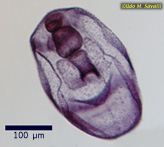
Bipinnaria larva of a sea star
|
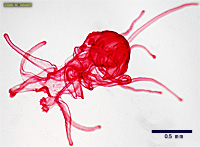
Brachiolaria larva of a sea star
|
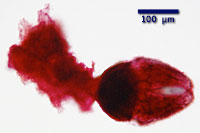
Pedicellaria from a sea star (stained slide)
|
|
Class Crinoidea — Sea Lilies & Feather Stars
Characteristics
- Body (=calyx) is cup-shaped with oral surface upwards
- Arms have numerous tiny branches (pinnules)
- Anus opens on oral surface
- Supported by aboral stalk (sea lilies) or tentacle-like cirri (feather stars)
- Suspension feeder in deep-sea environments
See additional fossil crinoids here

Models of extinct crinoids. The large image indicates the genus and geological period of each. Note that the Scyphocrinites (on right) has its calyx pointing down, with floats at the "root" end.
|
|
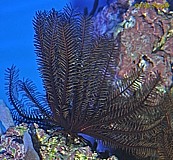
Feather Star, possibly Comantheria sp.?
|
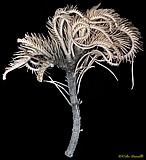
Japanese Sea Lily, Metacrinus rotundus, dried specimen
|



Sea Lily Specimens, from left to right:, Neocrinus blakei, Cenocrinus asterius, Endoxocrinus prionodes
|
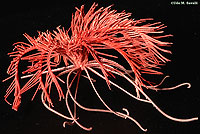
Feather Star, dried specimen
|
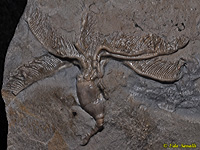
Fossil of Dichocrinus multiplex crinoid; Mississipian Period, IA
|

Fossil of Culicocrinus thomasi (left) & Rhodocrinites douglassi (right); Mississipian Period, IA
|
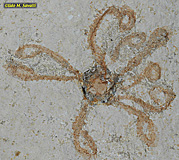
Fossil of Saccocoma pectinata, a floating crinoid; Jurassic Period, Germany
|

Fossil of Ectinocrinus sp. Sea Lily calyx; Ordovician Period, KY
|
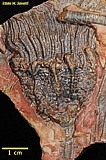
Fossil of Scyphocrinites sp. calyx a floating species in which the calyx hangs down (see model); Silurian Period, Morocco
|
|
Class Asteroidea — Sea Stars
Characteristics
- Body star-shaped with 5 or more arms
- Arms relatively thick; not distinct from central body disk
- Tube feet lie in open ambulacral grooves
- Gonads and digestive tract extend into arms
- Madreporite (opening to water vascular system) and anus aboral
- Mostly slow-moving predators
|
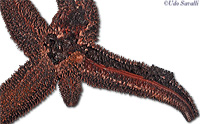
Dissected Sea Star, Asterias sp.
See also labeled photo (2 views).
|
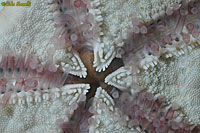
Mouth and oral surface of a Chocolate Chip Seastar, Protoreaster nodosus
See also labeled photo.
|

Dried Endoskeleton of a Cushion Star, Oreaster reticularis
|
|
|
|
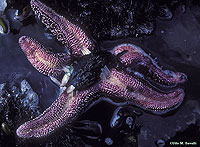
Ochre Sea Star, Pisaster ochraceus, eating mussel (Mytilus sp.) (turned oral surface up; note ambulacral grooves and tube feet); CA
|

African Red Knob Sea Star, Protoreaster linckii, Kenya
|
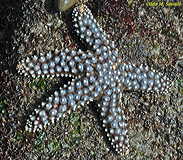
Giant Spined Star, Pisaster gigantea; San Diego, CA
|
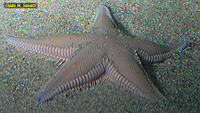
Spiny Sand Star, Astropecten armatus
|
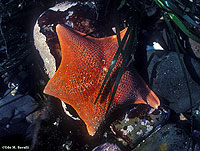
Bat Star, Patiria miniata, CA
|
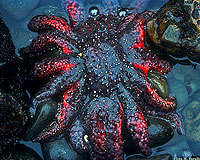
Sunflower Star, Pycnopodia helianthoides; a top predator that feeds on other sea stars; CA.
|
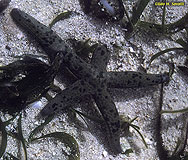
Linkia Seastar, Linckia sp.; the large arm was shed by the parent; the four shorter arms regenerated from this arm; Kenya.
|
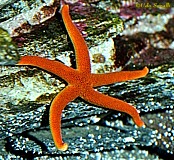
Pacific Blood Star, Henricia leviuscula
|
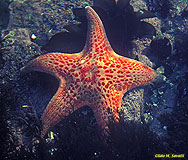
Leather Star, Dermasterias imbricata; CA.
|
|
Class Ophiuroidea — Brittle & Basket Stars
Characteristics
- Five arms articulated; distinct from body disk
- Arms may be branched (basket stars) or unbranched (brittle stars)
- Arms lack open ambulacral groove
- Lack anus
- Most are deposit or suspension feeders
|
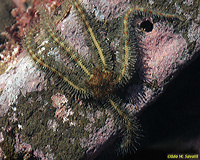
Western Spiny Brittlestar, Ophiothrix spiculata; CA
|
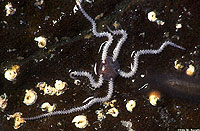
Little Brittlestar, Amphipholis pugetana; note regenerating arms; CA
|
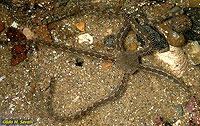
Banded Brittlestar, Ophionereis annulata; CA
|
|
|
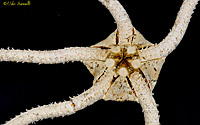
Dried Brittlestar, possibly Ophiarachnella sp.; ventral view
See also labeled photo.
|

Banded-arm Brittlestar, probably Ophioderma appressum?
|
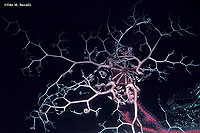
Basket Star, Gorgonocephalus sp.
|
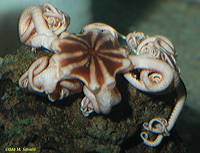
Basket Star, Gorgonocephalus sp.
|
|
Class Echinoidea — Sea Urchins
Characteristics
- Body globular or disk-shaped; lack arms
- Skeletal plates fused into rigid test
- Pores in test allow tube feet to exit
- Spines moveable
- Protrusible jaw apparatus (Aristotle's Lantern)
- Mostly herbivores or detritivores, but some predatory
|
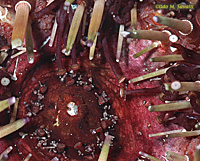
Closeup of mouth of live reef urchin, Echinometra viridis
See also labeled photo.
|
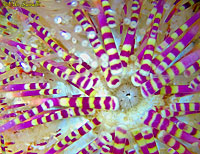
Closeup of mouth of live variegated sea urchin, Lytechinus variegatus
See also labeled photo.
|
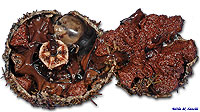
Dissected Sea Urchin, Strongylocentrotus sp.
See also labeled photo.
|
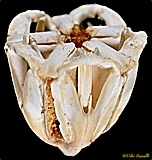
Aristotle's Lantern, the feeding apparatus of derived echinoids, Echinometra viridis
|
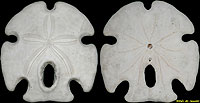
Giant Keyhole Sand Dollar, Encope grandis; aboral and oral view of test.
See also labeled photo.
|

Sand Dollar fossil, Dendraster gibbsii; Pliocene Epoch, CA.
See also labeled photo.
|
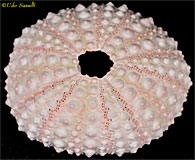
Test of a Pink Sea Urchin,
See also labeled photo.
|
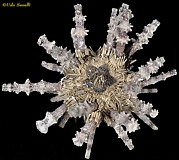
Crown-spined Urchin, Plococidaris verticillata, dried test, oral side up
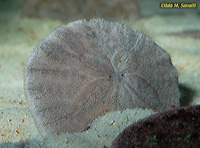
Eccentric Sand Dollar, Dendraster excentricus
|

Heart Urchin, Maretia planulata, dried
|
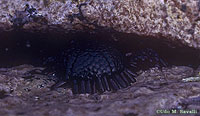
Shingle Urchin, Colobocentrotus atratus; HI
|
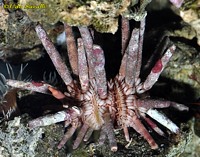
Slate Pencil Urchin, Eucidaris tribuloides
|

California Purple Urchins, Strongylocentrotus purpuratus; CA
|
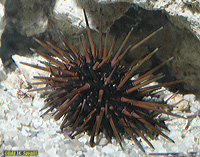
Reef Urchin, Echinometra viridis
|
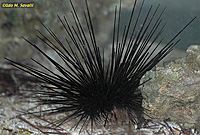
Black Long-spined Urchin, Diadema setosum
|
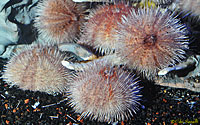
Fragile Pink Urchins, Allocentrotus fragilis
| |
|
Class Holothuroidea — Sea Cucumbers
Characteristics
- Body elongated in oral-aboral axis
- Secondarily bilaterally symmetric (no dorsal tube feet)
- Skeleton reduced to isolated ossicles; soft-bodied
- Ring of tentacles around mouth
- Most are deposit feeders in soft sediments
|
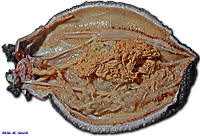
Dissected Sea Cucumber, Cucumaria frondosa
See also labeled photo.
|
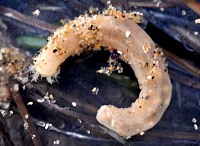
Burrowing Sea Cucumber, Leptosynapta albicans, San Diego, CA
|
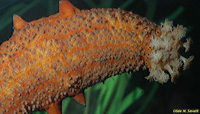
Warty Sea Cucumber, Parastichopus parvimensis, showing "ventral" tube feet and tentacles.
|
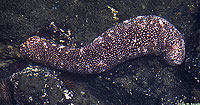
Speckled Sea Cucumber, Actinopyga mauritiana; HI
|
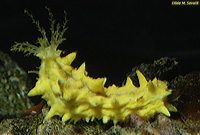
Yellow Sea Cucumber, Colochirus robustus, a suspension feeder
|
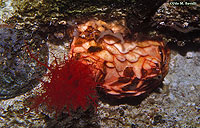
Armored Sea Cucumber, Psolus chitonoides, a sedentary suspension feeder
|
|
Extinct Echinoderm Classes
In addition to the 5 extant classes, there are also many extinct groups of Echinoderms
- Some were stalked suspension feeders, similar to crinoids
- Primitive forms were bilaterally symmetric or asymmetric
- You do not have to know these classes
See additional fossils of extinct echinoderm classes here

Models representing several extinct classes of echinoderms. Genera and class are identified in the large image. All date to the Ordovician Period.
|
|
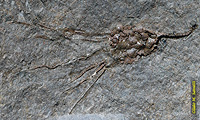
Fossil Eocrinoid, Gogia palmeri; Cambrian Period, ID (Class Eocrinoidea)
|

Fossil Eocrinoid, Ascocystites sp.; Ordovician Period, Morocco (Class Eocrinoidea)
|

Fossil Carpoid, Dendrocystites sp.; Ordovician Period, Morocco (Class Homoiostelea)
|
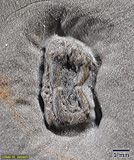
Fossil Ctenocystoid, Ctenocystis utahensi; Cambrian Period, UT (Class Ctenocystoidea)
|
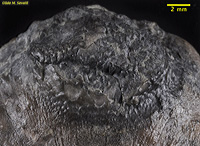
Fossil Edrioasteroid, Isorophus cincinnatiensis, on a brachiopod shell; Ordovician Period, OH (Class Edrioasteroidea)
|
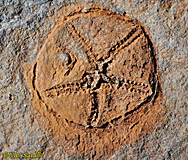
Fossil Edrioasteroid, Spinadiscus lefebvrei; Ordovician Period, Morocco (Class Edrioasteroidea)
|
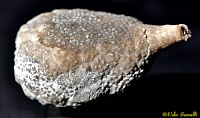
Fossil Cystoid, Holocystites sp.; Silurian Period, IN (Class Cystoidea); the mouth is at the left.
|
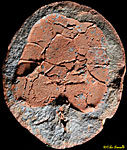
Stylophoran Fossil, Mitrocystites mitra; Ordovician Period, Chechia (Class Stylophora). The "tail" at the bottom is probably homologous to the stalk in crinoids, but was used to pull the animal across or through the substrate.
|
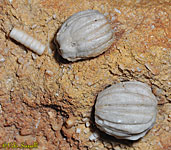
Fossil Blastoids, Cryptoblastus melo; Mississippian Period, IL (Class Blastoidea). In life, the mouth is toward the right on both.
|
|
|

































































